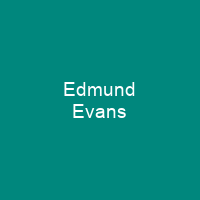Edmund Evans: A Master Printer of Victorian Era
Imagine a time when books were not just words on paper but vibrant tales brought to life through intricate illustrations and full-color prints. This was the era of Edmund Evans, an English wood-engraver and color printer who played a pivotal role in transforming children’s literature during the Victorian period. Born in 1826, Evans was destined to become one of the most celebrated printers of his time, known for his meticulous attention to detail and innovative techniques.
Early Beginnings
Evans’ journey began in Southwark, London, where he attended school at Jamaica Row. His early career took a turn when he started working as a ‘reading boy’ at the printing house of Samuel Bentley in 1839. This experience laid the foundation for his future endeavors. In 1840, Evans embarked on an apprenticeship with wood-engraver Ebenezer Landells, setting the stage for his eventual success.
Artistic Collaborations and Innovations
One of the most significant aspects of Evans’ career was his collaboration with renowned illustrators such as Walter Crane, Randolph Caldecott, Kate Greenaway, and Richard Doyle. These partnerships allowed him to produce classic children’s books that revolutionized the field. His use of chromoxylography—a technique involving woodblock printing to achieve full-color images—was groundbreaking for its time.
Evans was not just a printer; he was an innovator. He developed methods for color relief printing, using a background detail plate printed in aquatint intaglio followed by colors printed in oil inks from relief plates. This process allowed him to create facsimiles of watercolor illustrations and produce inks that closely emulated the original pigments.
Business Ventures and Expansion
After establishing his own business, Evans focused on producing children’s toy books and picture books for Routledge and Warne. He designed ‘yellow-backs,’ a method of printing books with yellow-glazed paper over boards, which became popular among London publishers.
Evans’ business expanded significantly in the 1860s when he leased space on Fleet Street to add steam engines, boilers, and extra machines. His work included notable projects such as an edition of Oliver Goldsmith’s poems illustrated by Foster, published in 1859, and James Doyle’s A Chronicle of England.
Collaborations with Notable Illustrators
The collaboration between Evans and Walter Crane, Kate Greenaway, and Randolph Caldecott was particularly fruitful. Their work on children’s books brought an immense improvement in colored picture books for children in the last quarter of the 19th century. For instance, in 1865, Evans agreed with Routledge and Warne to provide toy books—paperbound books of six pages sold for sixpence each. These ‘toy books’ revolutionized the field of children’s literature.
Evans’ work with Kate Greenaway was especially noteworthy. She sold him her poetry manuscript ‘Under the Window,’ which Evans printed in 20,000 copies despite initial skepticism from critics. This project marked a turning point for both artists and solidified their partnership.
Late Career and Legacy
As his career progressed, Evans continued to innovate. He converted to the three-color printing technique in 1902, using the Hentschel three-color process to print Beatrix Potter’s illustrations for her first book, The Tale of Peter Rabbit. His final years were spent writing The Reminiscences of Edmund Evans, reflecting on his life and work.
Evans’ legacy endures through the books he printed and the techniques he pioneered. Even today, plates made from original wood-blocks engraved by Edmund Evans are still used in reprints, a testament to his enduring influence on printing and illustration.

Edmund Evans’ contributions to the world of printing and illustration are a reminder that innovation and collaboration can transform an industry. His meticulous eye for detail, combined with his willingness to experiment, set him apart as one of the most influential printers of the Victorian era.
In conclusion, Edmund Evans was not just a printer; he was a visionary who helped shape the future of children’s literature through his innovative techniques and collaborations. His work continues to inspire artists and printers today, making him an enduring figure in the history of printing.
You want to know more about Edmund Evans?
This page is based on the article Edmund Evans published in Wikipedia (retrieved on December 2, 2024) and was automatically summarized using artificial intelligence.







